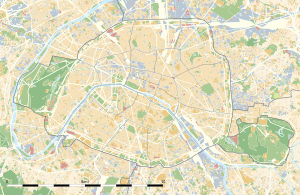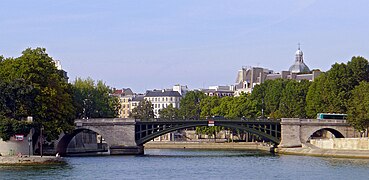Pont de Sully
Coordinates: 48 ° 51 ′ 0 ″ N , 2 ° 21 ′ 31 ″ E
| Pont de Sully | ||
|---|---|---|
| use | Road bridge | |
| Crossing of | His | |
| place | Paris | |
| construction | cast iron arch bridge | |
| width | 20 m | |
| Number of openings | 3 or 1 | |
| opening | 1877 | |
| location | ||
|
|
||
Pont de Sully (also Pont Sully ) is the name of two independent bridges in Paris that cross in a straight line the two arms of the Seine , separated by the southern tip of the Île Saint-Louis . They connect Boulevard Saint-Germain on the left bank with Boulevard Henri IV on the right bank. The next bridge upstream is the Pont d'Austerlitz , downstream the Pont de la Tournelle over the left and the Pont Marie over the right arm of the Seine.
The Pont de Sully is one of the few remaining cast iron bridges in France.
history
Between 1836 and 1838, two suspension bridges for pedestrians were built on the site , the Passerelle de Constantine over the left and the Passerelle Damiette over the right arm of the river. The latter was destroyed during the February Revolution in 1848 , the first collapsed in 1872 due to a cable break due to corrosion.
According to the urban planning developed by Haussmann , the two bridges were built in 1876 according to the plans of Gustave Brosselin and Paul Vaudrey and opened in 1877. It was named after Maximilien de Béthune, duc de Sully .
description
The 159 m long bridge over the left arm of the Seine has three cast iron segment arches with spans of 46 + 49 + 46 m, which are supported on stone pillars and abutments . It is 20 m wide, of which 12 m is accounted for by the carriageway and 4 m for each of the two sidewalks.
The bridge over the narrow right arm of the river has a cast-iron segment arch with a span of 42 m between massive stone abutments, each of which is adjoined on the outside by a brick round arch with a width of 15 m. It is also 20 m wide. On the outer arch support, next to the abutment, you can see the marking of Henri Joret's foundry: H. Joret et Cie Constructeurs a Paris Entrepreneurs. / 1875 / Fonderies de la Cie de Terre-Noire La Voulte et Besseges.
Both bridges lie in one axis, thus crossing the river arms at (different) oblique angles, while the abutments and piers are aligned with the river arms. The bridge fields are therefore not right-angled, but have the plan of a parallelogram .
Web links
Individual evidence
- ↑ Bernard Marrey: Les Ponts Modern; 18 e –19 e siècles. Picard éditeur, Paris 1990, ISBN 2-7084-0401-6 , p. 156
- ↑ Bridges of Paris on LCPC, now Ifsttar





